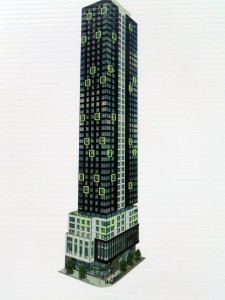A tower of cubbyholes built to yesterday’s standards
By Terri Chu

Architect’s rendering of the proposed 42-storey tower for 316 Bloor St. W. Photo courtesy 316 Bloor West Developments Ltd.
I have to admit, I’m not particularly fond of the development proposal at 316 Bloor St. W. First off, one has to ask what is the point of an 18-metre height restriction when developers think a 132-metre building proposal is fine and dandy. However, I digress. I’m more concerned about the environmental impact of their plan.
It is important to note that, in general, high density living means a lower environmental footprint. This is not some mere speculation but has actually been calculated and demonstrated based on a comparison between condo and suburban living. The big driver for this decrease is transportation energy. Having learned the craft of Life Cycle Analysis from some of the best minds in the field, I will say with confidence that the math is only as good as the assumptions we make. There is no doubt that people who live within biking/walking/transit distance to where they need to go will create far fewer emissions than people who drive SUVs to the corner store. The 316 Bloor St. proposal has 535 bike parking spaces for its projected 535 units. However, what we often don’t consider is the secondary energy use.
The plan includes units ranging in size from 275 to 644 square feet. To put that into perspective, my university dorm room was not much bigger than 275 square feet. When there’s a lack of space to enjoy yourself in your own home, entertain friends, and cook food, we tend to fill those needs outside our own space. A 30-minute visit to any condo lobby in City Place will show that the majority of groceries going up in the elevators consists of prepared food in single-use disposable containers. It is hard to blame this on anyone trying to cook in a kitchen with a footprint as a big as a tea towel. Any kind of sustainability initiative on the transportation front is made moot by a mountain of Styrofoam clamshells in the back dumpster.
A tall, narrow building design increases the surface-area to volume-ratio of the building, which results in a lot of surface area from which heat is lost. The developer answered my concerns about high levels of heat loss by assuring me that the building would be compliant with Ontario’s building code … a building code that was last updated three years ago to finally include some standards put forth in the 1980s. That’s about as reassuring as knowing a vintage car meets postwar era emission standards. From a developer in one of the most populous cities in Canada, I think it’s reasonable to ask for leadership in sustainability, not code followers. The current building code will basically allow it to leak like a sieve while everyone turns on their space heaters to keep warm. Flickering lights of late already indicate that we are under severe stress on our electricity grid, and we really don’t need another energy hog to make matters worse.
I’m all for higher density living, but I’m not convinced that this project will lead to higher levels of sustainability. By merely meeting the minimum requirements of the building code and creating units that will foster a need to eat takeout, I don’t believe this development will make our community greener in the slightest.
Sustainability means we do it right and take into account how to make the space liveable, reduce carbon (including secondary effects like buying things made elsewhere), and lessen the impact on the overall neighbourhood. If young people living in cubbyholes don’t have enough space to cook and need to eat prepared food, the local businesses will adjust to their needs. It also means an increase in the availability of those products and a decrease in the availability of goods with less packaging.
Sustainability means looking at the whole picture. The development at 316 Bloor St. W. takes a view as narrow as the building itself.

1 response so far ↓
1 Christopher King // May 8, 2015 at 4:21 pm
I don’t mind the look of the proposed condo, but I completely agree with the author about the ridiculous size of the units. Mind you, Tokyo has made do with far less.